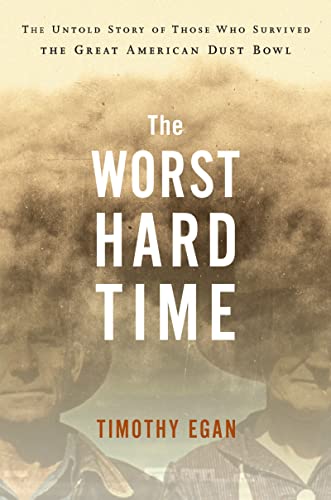The Worst Hard Time: The Untold Story of Those Who Survived the Great American Dust Bowl - Hardcover

The dust storms that terrorized America's High Plains in the darkest years of the Depression were like nothing ever seen before or since, and the stories of the people that held on have never been fully told. Pulitzer Prize–winning New York Times journalist and author Timothy Egan follows a half-dozen families and their communities through the rise and fall of the region, going from sod homes to new framed houses to huddling in basements with the windows sealed by damp sheets in a futile effort to keep the dust out. He follows their desperate attempts to carry on through blinding black blizzards, crop failure, and the deaths of loved ones. Drawing on the voices of those who stayed and survived—those who, now in their eighties and nineties, will soon carry their memories to the grave—Egan tells a story of endurance and heroism against the backdrop of the Great Depression.
As only great history can, Egan's book captures the very voice of the times: its grit, pathos, and abiding courage. Combining the human drama of Isaac's Storm with the sweep of The American People in the Great Depression, The Worst Hard Time is a lasting and important work of American history.
Timothy Egan is a national enterprise reporter for the New York Times. He is the author of four books and the recipient of several awards, including the Pulitzer Prize. He lives in Seattle, Washington.
“As one who, as a young reporter, survived and reported on the great Dust Bowl disaster, I recommend this book as a dramatic, exciting, and accurate account of that incredible and deadly phenomenon. This is can’t-put-it-down history.” —Walter Cronkite
"The Worst Hard Time is wonderful: ribbed like surf, and battering us with a national epic that ranks second only to the Revolution and the Civil War. Egan knows this and convincingly claims recognition for his subject—as we as a country finally accomplished, first with Lewis and Clark, and then for 'the greatest generation,' many of whose members of course were also survivors of the hardships of the Great Depression. This is a banner, heartfelt but informative book, full of energy, research, and compassion." —Edward Hoagland, author of Compass Points: How I Lived
"Here's a terrific true story—who could put it down? Egan humanizes Dust Bowl history by telling the vivid stories of the families who stayed behind. One loves the people and admires Egan's vigor and sympathy." —Annie Dillard, author of Pilgrim at Tinker Creek
"The American West got lucky when Tim Egan focused his acute powers of observation on its past and present. Egan's remarkable combination of clear analysis and warm empathy anchors his portrait of the women and men who held on to their places—and held on to their souls—through the nearly unimaginable miseries of the Dust Bowl. This book provides the finest mental exercise for people wanting to deepen, broaden, and strengthen their thinking about the relationship of human beings to this earth." —Patricia N. Limerick, author of The Legacy of Conquest: The Unbroken Past of the American West
"synopsis" may belong to another edition of this title.
"About this title" may belong to another edition of this title.
- PublisherHoughton Mifflin
- Publication date2005
- ISBN 10 061834697X
- ISBN 13 9780618346974
- BindingHardcover
- Edition number1
- Number of pages352
- Rating
Buy New
Learn more about this copy
Shipping:
US$ 4.00
Within U.S.A.
Top Search Results from the AbeBooks Marketplace
The Worst Hard Time: The Untold Story of Those Who Survived the Great American Dust Bowl
Book Description Hardcover. Condition: new. New. Fast Shipping and good customer service. Seller Inventory # Holz_New_061834697X
The Worst Hard Time: The Untold Story of Those Who Survived the Great American Dust Bowl
Book Description Hardcover. Condition: new. New Copy. Customer Service Guaranteed. Seller Inventory # think061834697X
The Worst Hard Time: The Untold Story of Those Who Survived the Great American Dust Bowl
Book Description Condition: new. Seller Inventory # newMercantile_061834697X
The Worst Hard Time: The Untold Story of Those Who Survived the Great American Dust Bowl
Book Description Hardcover. Condition: new. Excellent Condition.Excels in customer satisfaction, prompt replies, and quality checks. Seller Inventory # Scanned061834697X
The Worst Hard Time: The Untold Story of Those Who Survived the Great American Dust Bowl
Book Description Condition: new. Seller Inventory # FrontCover061834697X
The Worst Hard Time: The Untold Story of Those Who Survived the Great American Dust Bowl
Book Description Condition: New. Book is in NEW condition. Seller Inventory # 061834697X-2-1
The Worst Hard Time: The Untold Story of Those Who Survived the Great American Dust Bowl
Book Description Condition: New. New! This book is in the same immaculate condition as when it was published. Seller Inventory # 353-061834697X-new
The Worst Hard Time: The Untold Story of Those Who Survived the Great American Dust Bowl
Book Description Hardcover. Condition: new. New. Seller Inventory # Wizard061834697X
The Worst Hard Time: The Untold Story of Those Who Survived the Great American Dust Bowl
Book Description Condition: new. Seller Inventory # Hafa_fresh_061834697X
The Worst Hard Time: The Untold Story of Those Who Survived the Great American Dust Bowl
Book Description hardcover. Condition: New. Seller Inventory # A10-112tim

